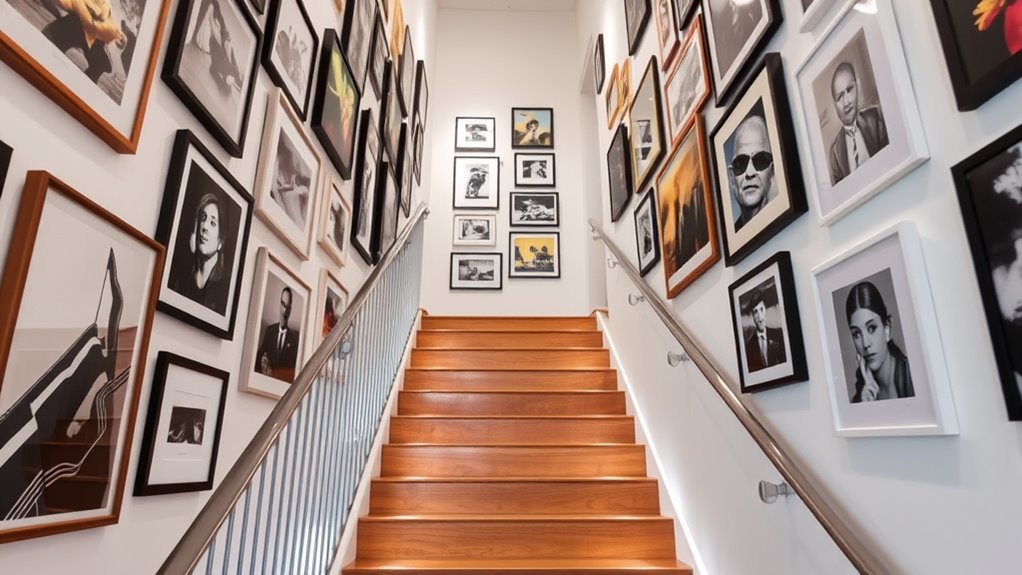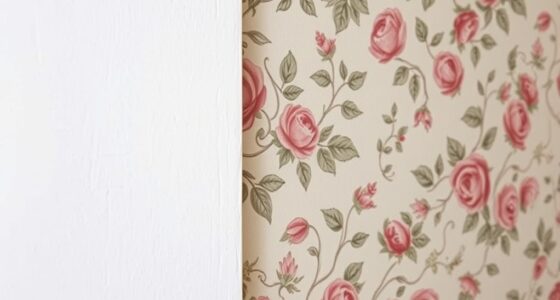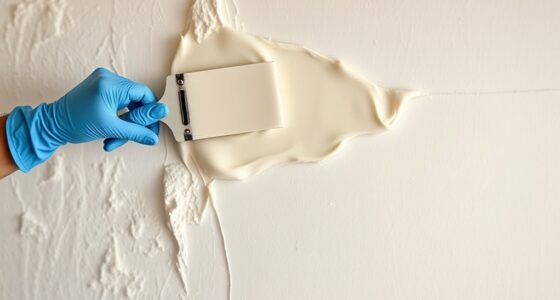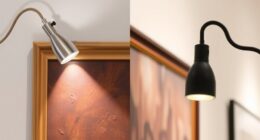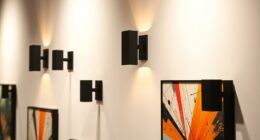To create a stunning staircase gallery wall following the rise, start by choosing a spot with good natural or adjustable lighting. Plan your layout to follow the staircase’s natural flow, using painter’s tape to visualize spacing and alignment. Measure carefully for uniformity and make sure frames are secure. Incorporate personal touches and balance visual weight to make it cohesive. Keep these tips in mind, and you’ll master this impactful display—there’s much more to explore if you continue behind the scenes.
Key Takeaways
- Plan your layout along the staircase’s rise and fall, maintaining even spacing or visual blocks for harmony.
- Use painter’s tape and paper templates to visualize the arrangement before hanging.
- Measure and mark key points to ensure consistent height and spacing between artwork pieces.
- Follow the natural flow by aligning artwork with the staircase’s angle, creating a cohesive visual path.
- Consider lighting placement to highlight the gallery wall and enhance the staircase’s architectural features.
Choosing the Perfect Spot for Your Gallery

Have you ever wondered where the best place is to showcase your gallery wall? The ideal spot is where lighting placement enhances your artwork without causing glare or shadows. Natural light is perfect if it’s indirect, but if you rely on artificial lighting, opt for adjustable fixtures to highlight your pieces. Additionally, consider wall color coordination; choose a wall color that complements your artwork and frames. Lighter walls can make colors pop, while darker walls add depth and sophistication. Keep in mind that the staircase’s natural flow guides the eye, so selecting a wall that’s easily visible and accessible is key. By combining thoughtful lighting placement with well-coordinated wall colors, your gallery will become a striking focal point. Utilizing lighting placement that maximizes natural and artificial light can further enhance your display and create an inviting atmosphere, especially when considering how dream symbolism can influence the emotional impact of your space.
Planning Your Layout and Design
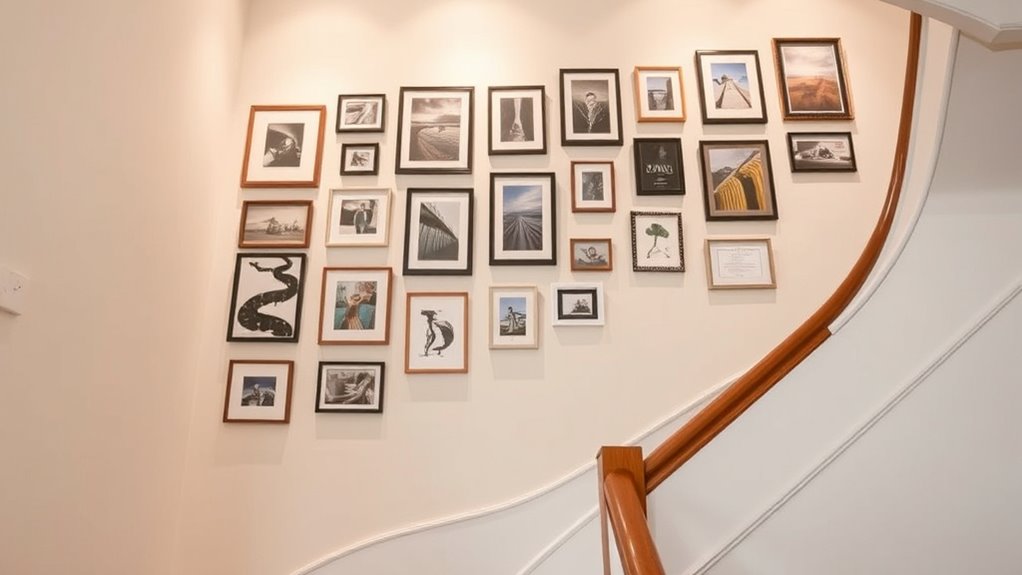
To create a cohesive and visually appealing staircase gallery wall, start by planning your layout before hanging any artwork. Consider your color schemes—choose hues that complement your wall and overall decor for a harmonious look. Think about how different pieces will flow together along the staircase’s rise and fall, spacing them evenly or intentionally creating visual blocks. Lighting options are vital; incorporate accent lighting or picture lights to highlight key pieces and add depth to your display. Visualize the arrangement first by laying out paper templates or using digital tools to experiment with placement. This planning step helps ensure your gallery feels balanced, intentional, and tailored to your space, making the actual installation smoother and more satisfying. Incorporating strategic lighting can elevate the mood and aesthetic appeal of your gallery wall. Additionally, considering the visual flow along the staircase can help create a more dynamic and engaging display. Paying attention to art placement can also prevent a cluttered look and ensure each piece has space to breathe. Being mindful of proportion and scale will further enhance the overall harmony of your gallery layout.
Selecting Frames and Artwork
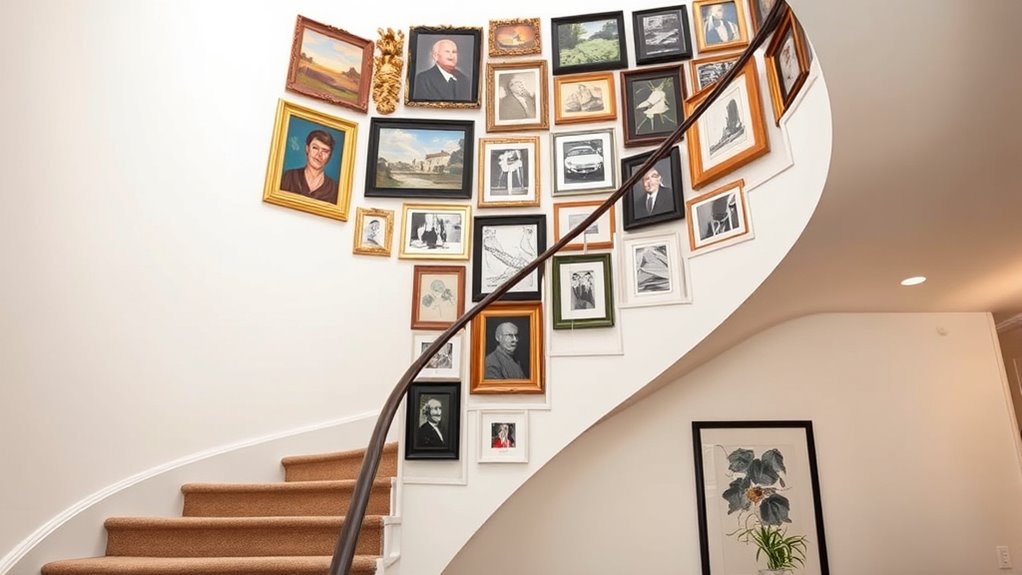
Once you’ve planned your layout, selecting the right frames and artwork becomes the next step in creating a cohesive staircase gallery wall. Your choice of frame styles impacts the overall vibe—go for sleek modern, vintage, or ornate designs to match your space. Make sure your artwork complements your decor and evokes emotion:
- Choose pieces that tell a story or hold personal meaning.
- Incorporate gallery lighting to highlight key artwork and add depth.
- Select frames that enhance your art without overpowering it.
Balancing different frame styles creates visual interest, while thoughtful gallery lighting draws attention to your favorite pieces. Keep your artwork varied but harmonious, ensuring each piece enhances the overall rise of your staircase gallery.
Measuring and Marking Your Wall
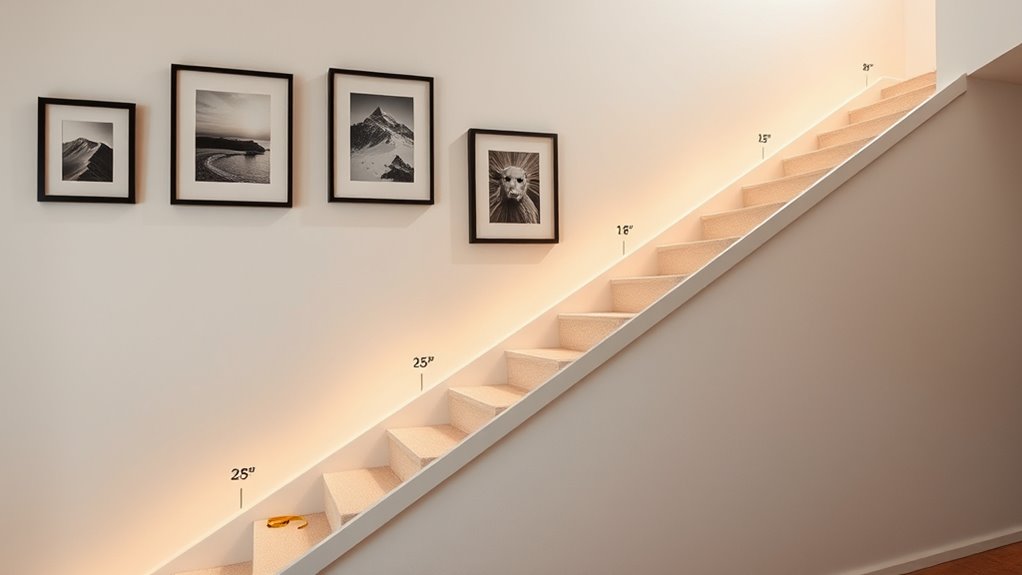
Start by gathering your tools, like a tape measure, level, and pencil, to guarantee accuracy. Next, plan your layout pattern on paper or directly on the wall to visualize the arrangement. To ensure proper spacing and alignment, consider using vertical storage solutions to maximize organization. Incorporating a digital planning tool can help you visualize your gallery before hanging. Additionally, understanding regional legal resources and local regulations can assist in making informed decisions about your space. It’s also helpful to research projector screen quality options to ensure the best viewing experience. Finally, mark key positions on the wall to guide where each frame will hang, making the process smoother.
Gather Necessary Tools
Before hanging your gallery wall, gather all the essential tools you’ll need for measuring and marking your wall. Having a complete tools checklist guarantees your project runs smoothly and safely. Proper preparation ensures that your display maintains a professional look and stays securely in place. 1. Tape measure – to get precise measurements and spacing. 2. Level – to keep your artwork perfectly straight and aligned. 3. Pencil and masking tape – for marking spots without damaging your wall. Don’t forget safety gear like goggles or gloves if you’re using tools like drills or hammers. Proper safety precautions protect you from potential accidents. With these tools, you’ll confidently measure, mark, and prepare your wall for a stunning staircase gallery. Being organized and prepared minimizes errors and helps you achieve that professional look. Additionally, understanding Gold IRA options can be helpful if you’re considering investment diversification alongside home decor projects. It’s also beneficial to familiarize yourself with home improvement tips to streamline your decorating process. Now, you’re ready to move forward with your plan and create a beautiful display!
Plan Layout Pattern
With your tools ready, it’s time to plan your layout pattern to guarantee a balanced and visually appealing gallery wall. Start by considering your color schemes to assure your artwork complements your space’s overall palette. Think about lighting considerations too—where natural or artificial light hits the wall can influence how colors appear and how shadows fall. Measure and mark key points on the wall, keeping in mind the height and spacing that work best for your staircase. Use painter’s tape to outline your desired arrangement, helping you visualize the pattern before hanging. This step ensures your gallery wall feels cohesive and tailored to your space, making the actual hanging process smoother and more precise. Incorporating planning frameworks can further aid in designing a harmonious layout.
Mark Key Positions
Measuring and marking your wall accurately is essential to make sure your gallery wall looks balanced and professional. Start by identifying key positions where shadows will fall, ensuring consistent shadow alignment for depth. Use a level to mark your baseline, keeping your pieces aligned along the staircase’s rise. Pay attention to color coordination; mark spots that highlight contrasting or complementary hues, creating visual harmony. Incorporate professional equipment such as laser levels or measuring tools to achieve precise placement and enhance your overall design. Additionally, considering tuning adjustments can help you better visualize how light and shadow will interact with your artwork’s placement. Properly calibrated lighting and architectural solutions can further elevate the visual impact of your gallery wall. Here are three steps to follow: 1. Measure the height of each artwork, marking key points to maintain even spacing. 2. Use painter’s tape to visualize shadow alignment, ensuring each piece’s shadow flows naturally. 3. Adjust your marks to balance color distribution, making sure each element complements the next. Incorporating precise measurements ensures your arrangement appears cohesive and polished. These precise markings set the foundation for a stunning, cohesive gallery wall.
Techniques for Hanging and Securing Pieces
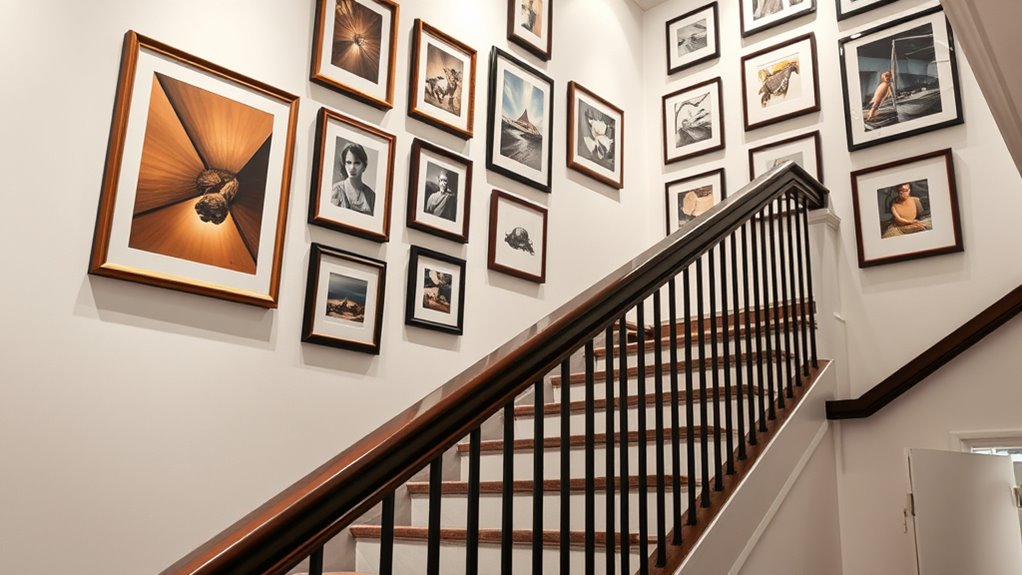
Hanging and securing pieces for a staircase gallery wall requires careful techniques to guarantee stability and visual appeal. Start with proper hanging techniques, such as using level rulers and measuring tape to ensure each frame aligns correctly. Use appropriate hardware like picture hooks, wall anchors, or D-rings based on your wall type and frame weight. When securing your artwork, double-check that hooks or wires are firmly attached to prevent slips. For added stability, consider using museum putty or adhesive strips for lightweight pieces. Be precise with your measurements to keep the arrangement even and balanced. Regularly step back and view your progress to make adjustments as needed. Additionally, understanding how arcade games work can inspire creative display ideas, such as incorporating vintage gaming decor or themed artwork. Using the right wall anchoring techniques helps create a polished, secure display that elevates your staircase’s aesthetic. Incorporating proper lighting can also highlight your gallery wall and enhance its overall appeal.
Creating a Cohesive Visual Flow
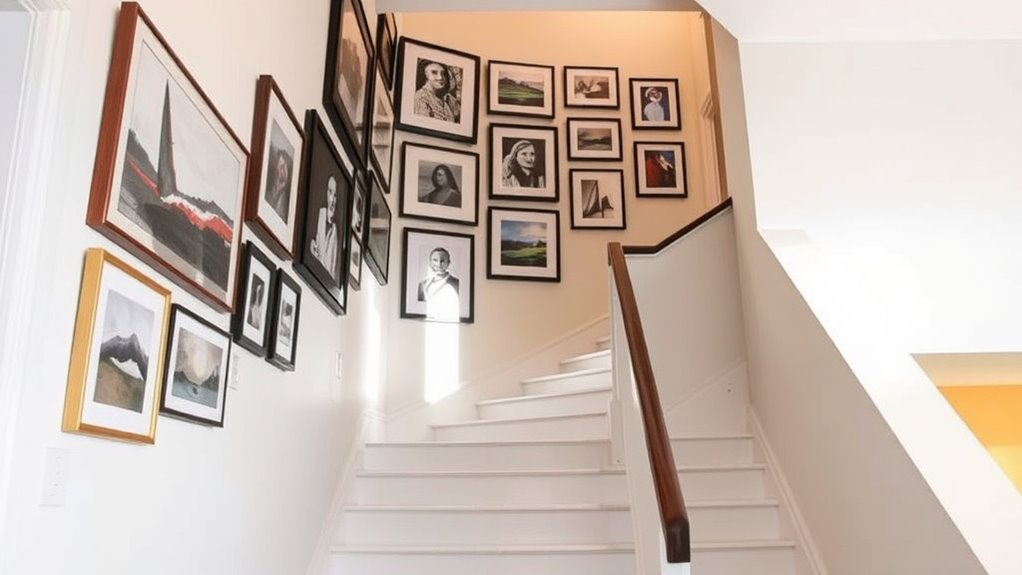
Creating a cohesive visual flow in your staircase gallery wall guarantees that each piece complements the others and guides the viewer’s eye smoothly from one artwork to the next. To achieve this, focus on color coordination and thematic consistency. When your pieces share a common color palette or theme, your display feels unified and intentional. Consider these tips:
- Use similar hues across your artwork to evoke a sense of harmony and calm.
- Select themes or styles that resonate together, creating a narrative or mood.
- Balance visual weight by spacing pieces evenly, ensuring no single area feels overwhelming.
- Incorporate best beaches as inspiration for your color schemes and themes, adding a touch of serenity and natural beauty to your display. Additionally, integrating visual harmony principles can further enhance the flow and cohesion of your gallery wall.
Incorporating Personal Touches and Memories
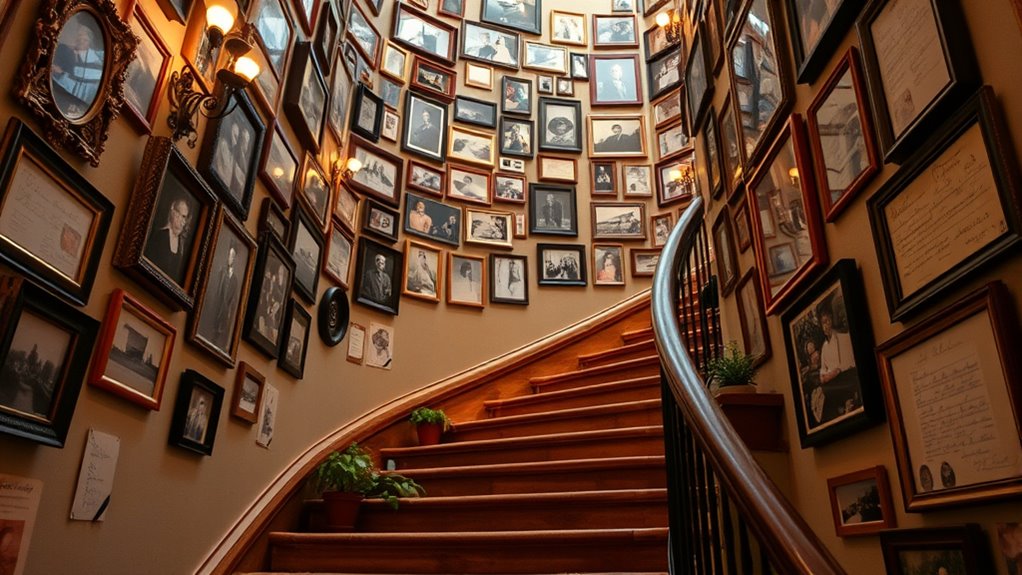
Adding personal touches and memories to your staircase gallery wall transforms it from a simple display into a meaningful reflection of your life. Incorporate family mementos and personal memorabilia that tell your story. These items create emotional connections, making the space uniquely yours. Consider framed photos of loved ones, heirlooms, or travel souvenirs. Mixing different types of memorabilia adds visual interest and depth. You can arrange them alongside artwork or prints for balance. Remember, every piece should evoke a memory or sentiment. Use varied sizes and shapes to keep the display dynamic. This personal touch not only celebrates your history but also invites guests to share in your stories.
| Item Type | Example | Placement Tips |
|---|---|---|
| Family mementos | Old letters, heirlooms | Center or focal point |
| Personal memorabilia | Travel souvenirs, awards | Spread throughout for balance |
| Photos | Candid family shots | Mix with artwork |
| Sentimental objects | Jewelry, keepsakes | Incorporate into frames or stands |
| Artistic items | Handmade crafts | Use as accents or background |
Maintaining and Updating Your Gallery Over Time
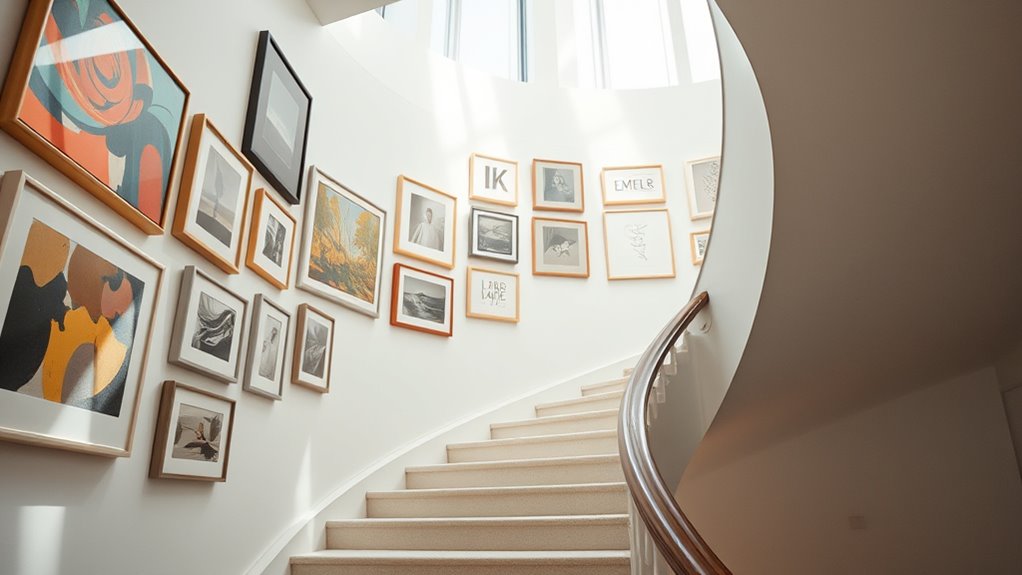
To keep your gallery fresh, try rotating your art selections regularly to showcase new pieces and keep the space lively. If a frame or artwork gets damaged, don’t hesitate to repair or reframe it to maintain a polished look. Staying proactive with these updates guarantees your staircase gallery remains inspiring over time.
Rotating Art Selections
By regularly swapping out artwork, you keep your staircase gallery fresh and engaging. This practice allows you to showcase different artwork themes and highlight your evolving taste. As you rotate pieces, consider how gallery lighting can enhance each display, creating mood and focus. To evoke emotion, think about:
- Surprise and delight – Unexpected changes keep viewers curious and enthusiastic to see what’s next.
- Connection and nostalgia – Reintroduce favorite pieces to foster memories and deepen engagement.
- Growth and evolution – Reflect your personal journey by updating artwork to mirror your experiences.
Repair and Reframe
Over time, even the best staircase gallery walls can suffer from wear, fading, or shifting arrangements. To keep your display fresh and protected, consider art conservation techniques to prevent further deterioration. When pieces become damaged or outdated, reframing can restore their appearance and structural integrity. Use framing techniques that enhance your artwork’s style and provide proper support, such as UV-protective glass or acid-free mats. Regularly inspect your gallery for loose nails or warping frames, and don’t hesitate to repair or replace damaged elements. Reframing allows you to update your collection’s look while safeguarding your art for years to come. Maintaining your gallery through careful repair and reframe efforts assure it continues to inspire and impress.
Inspiring Ideas for Unique Staircase Displays
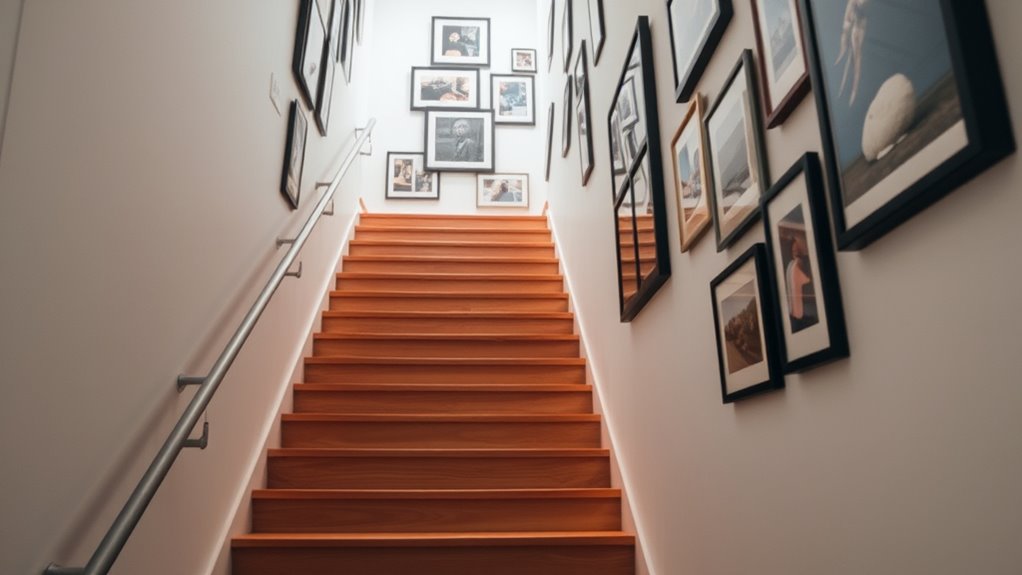
Elevating your staircase with a gallery wall offers an exciting opportunity to showcase your personality and style. To make it truly stand out, consider inspiring ideas that create a unique display. First, play with interior lighting—spotlights or wall sconces highlight your artwork and add warmth. Second, coordinate your wall color with your decor to create a seamless look that complements your space. Third, mix different frame styles and sizes to add visual interest and depth to your display. These elements evoke emotion by making your staircase a mesmerizing focal point. Remember, thoughtful wall color coordination and strategic lighting enhance the overall aesthetic, transforming your staircase into a personal art gallery that reflects your taste.
Frequently Asked Questions
How Can I Ensure My Gallery Wall Remains Balanced Over Time?
To keep your gallery wall balanced over time, regularly assess your frame arrangement to maintain visual harmony. Adjust or reposition frames as needed, especially if you notice uneven spacing or shifting. Use consistent frame styles or colors to unify the display. Take a step back periodically to view your wall from different angles, ensuring the arrangement remains harmonious and balanced as your collection grows or changes.
What Are the Best Lighting Options for Staircase Gallery Displays?
You should opt for wall sconces with adjustable fixtures or warm LED artificial lighting to highlight your staircase gallery. This creates a dramatic effect, drawing attention to each piece while maintaining a cozy ambiance. Position the sconces carefully along the staircase wall, ensuring even illumination without shadows. The right lighting transforms your display into a mesmerizing visual journey, revealing intricate details and adding depth to your gallery as you ascend.
How Do I Choose Artwork Sizes That Complement Each Other?
To choose artwork sizes that complement each other, focus on maintaining consistent frame spacing for a cohesive look. Mix larger and smaller pieces thoughtfully, ensuring they coordinate in style and color to achieve artwork harmony. You want a balanced arrangement where no piece overwhelms the others. Measure your wall space, plan your layout beforehand, and opt for varying but harmonious sizes to create an engaging, unified gallery wall.
What Adhesives Are Safe for Lightweight and Fragile Frames?
For lightweight and fragile frames, you should use adhesive tapes or putty specifically designed for frame preservation. Look for products labeled as safe for delicate surfaces and guarantee they offer adhesive safety to prevent damage. Avoid strong glues that could cause warping or discoloration. Always test a small area first to check for compatibility, and consider using removable adhesives for easy adjustments without harming your artwork.
How Can I Incorporate Seasonal or Rotating Pieces Effectively?
Imagine transforming your staircase gallery with seasonal updates by rotating displays every few months. You can start by dedicating one wall section for this purpose, swapping out artwork or photos to reflect holidays or seasons. Use lightweight frames with removable hooks for easy updates. This approach keeps your space fresh, engaging, and dynamic, allowing you to showcase new pieces regularly while maintaining a cohesive look throughout your rotating displays.
Conclusion
By following these tips, you can create a stunning staircase gallery that reflects your personality. For example, Sarah started with a simple photo collection and gradually added art and personal mementos, transforming her staircase into a captivating visual story. Remember, your gallery is a work in progress—don’t be afraid to update and rearrange as your collection grows. Keep it personal, balanced, and fun, and your staircase will become a beautiful showcase of your journey.
